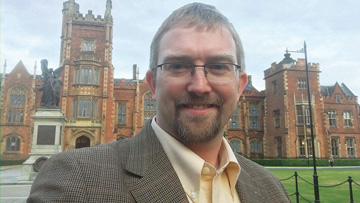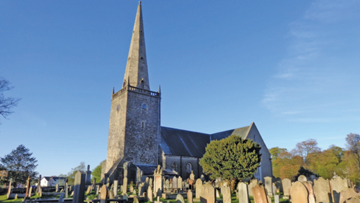As we join our fellow Protestants in commemorating the Reformation this year, we rightly look with them to Wittenberg and Geneva. But we also look to Edinburgh. The family of Reformed Presbyterian churches charts its descent from the Reformation in Scotland, where the story begins somewhat later than the rest of Europe. Although the light of the Reformation arrived there later, it would arguably shine there the brightest and the longest.
A Nation in Need of Reform
Scotland’s medieval church was notoriously corrupt, with much popular satire directed against her often-promiscuous and illiterate clergy. It wielded great economic power over a weak king and squabbling nobles. It possessed almost half the nation’s wealth and wielded an even greater spiritual power through its sacraments. As an extremely poor nation on the edge of Europe, Scotland, by the mid-16th Century, had become a political satellite of France and a pawn in her struggle against Protestant England. However, Scotland’s trade ties with continental Europe and her steady stream of students to and from established educational centers like Paris and Wittenberg would open the door to the new ideas that were stirring Europe.
One of these students was Patrick Hamilton. As a young priest, he came under the power of the gospel by reading Tyndale’s English Bible and banned Lutheran literature, eventually going to study with Martin Luther in Wittenberg. Upon his return, Hamilton preached the gospel in his parish and was condemned for heresy—slowly roasted alive on the orders of Cardinal Beaton in 1528. The first Scottish martyr of the Reformation, he became something of a national hero overnight. He would not be the last. As one contemporary pointed out, “The reek of Master Patrick Hamilton infected as many as it blew upon”—and the infection spread quickly. Despite brutal attempts to suppress the new Protestant faith by King James V, the tide was turning: increasing numbers of Scottish commoners and nobility were embracing the new faith, the latter often sincerely and yet also seeing an opportunity to increase their political power.
The Word Spreads
International diplomacy played a uniquely important role in the Scottish Reformation. When King James died, he left his 6-day-old successor Mary (the future Queen of Scots) and a succession crisis. As Catholic nobles struggled to retain the status quo, their Protestant opponents gave free rein in their lands to a rising generation of new itinerant preachers, the most influential of which was George Wishart. Before following Hamilton to the martyr’s stake in 1546, he would draw the Scottish Reformation into the orbit of the Swiss Reformation, translating Bullinger’s First Helvetic Convention of 1536 into Scots. But it was Wishart’s personal bodyguard and disciple who has ensured the Genevan flavor of the Scottish Reformed Churches ever since.
John Knox has become virtually synonymous with the Scottish Reformation. His statue stands tall in St. Giles’ Cathedral in Edinburgh to this day. Not much is known of his childhood, but his public career began dramatically when he became pastor of the Protestant rebels besieged by Catholic nobles in St. Andrews Castle in 1547. The revolt was short-lived. The castle fell to French forces, whose military heft quickly established James’ widow, Mary de Guise, as regent of Scotland until Princess Mary—then being raised in the French court—came of age and claimed her throne.
Young Mary was not the only player in our story being prepared for a dramatic future work in Scotland. Knox was banished from Scotland for 12 years: first as a French galley slave for 19 months, then serving as a chaplain to the Protestant English King Edward VI. Knox wrote several important treatises, helping Cranmer revise The Book of Common Prayer and ministering in several English congregations. Here he developed a reputation for his warm pastoral care and dedication to prayer. But like so many, Knox was compelled to flee England for his life during the brief reign of “Bloody Mary” Tudor. This took him to Calvin’s Geneva, where he pastored a congregation of English expats.
God Readies the Man for His Hour
These were extremely formative years for the Reformer, as he tasted and practiced a purer biblical doctrine of Word, sacraments, and church discipline than his homeland had ever yet experienced. He longed to see the lessons of what he termed “this perfect school of the prophets” implemented in Scotland. He watched and waited for his opportunity.
Back home, the Reformed cause had been slowly gaining ground. The Protestant nobility, increasingly resentful of the French regency and religious persecutions of Mary de Guise, were moved to enter into a covenant in 1557 “to set forward the blessed Word of God and His Congregation” in Scotland. Styling themselves “The Lords of the Congregation,” they brazenly established public preaching in their homes until such time as it would be established by law in the churches. To that end, they invited John Knox back home in 1559. Soliciting military help from English Queen Elizabeth I, they marched on Edinburgh and deposed Mary de Guise, thus ending French Catholic hegemony and cementing a long-term alliance with their fellow Protestant neighbor to the south.
Establishing the Reformation
If the traditional “year of Reformation” in continental Europe is 1517, in Scotland it is 1560. The great “Reformation Parliament” now set to work in Edinburgh and pronounced “condemnation of transubstantiation, justification by works, indulgences, purgatory, invocation of saints, papal authority and profanation of the sacraments, and restoration of the discipline of the early Church and a redistribution of the Church’s patrimony [i.e. wealth] in favor of the ministry, schools and poor.” This agenda was nothing less than the establishment of a national church that was Reformed in theology and Presbyterian in government—which would address not only the “religious” life of the nation but also urgent social concerns such as national education and poverty.
First, the Reformed theology of the church was enshrined in its subordinate standard, the Scots Confession of 1560. It contained 25 articles that affirmed core catholic Christian beliefs, demonstrating the Protestant church’s apostolic continuity with the past, but also boldly asserted the recovered Reformation doctrines of faith and repentance, the nature of justification, the sacraments, the true marks of the Church, etc. It was firmly in the Calvinist strand of the Reformation and its debt to Calvin’s Institutes is clear.
Next, the Presbyterian government and worship of the church were enshrined in the Book of Discipline (1560) and Book of Common Order (1564). At their heart was the restoration of the centrality of the Word of God to a largely illiterate nation. Jettisoning the deeply ingrained sacramentalism of the past, the Reformers relied instead on the power of the written, and particularly the preached, Word. The strictly enforced cycle of Roman festivals was replaced with a strictly enforced weekly Sabbath, which brought a nation under the sound of the gospel. On the remaining days of the week, their diet of the Word was supplemented by family worship, a new love of metrical psalmody, and regular catechesis, all of which were organized under the pastoral oversight of the local church session.
Our forefathers took seriously the importance of providing their young people with a theological foundation. The Book of Discipline called for a school in every parish paid for by the people’s tithes, which would no longer line the pockets of nobles and clergy. The curriculum was thoroughly Word-centered, and, in time, these schools built one of the most literate (and theologically literate) populations in early-modern Europe.
Perhaps the most striking feature of the Scottish Reformed kirk was its rigorous and successful application of discipline in the church courts. The first General Assembly of the Reformed Church of Scotland met in 1560 at Magdalen Chapel, Edinburgh, and would become the key battleground with nobles and kings as they vied for control of the church in subsequent years.
It would still be decades before regional presbyteries could be established, but from early days it was the local church sessions that would arguably have the greatest impact on Scottish life, ingraining the doctrine and discipline of the Reformation deep into the Scottish soul. The wealth of recorded session minutes that remain reveal an impressive network of interconnected local churches that were remarkably effective under God. They loosened the grip of ritualism and superstition from a nation by faithfully preaching the gospel of grace, administering the sacraments in their biblical simplicity, and patiently shepherding the flock of God.
As one contemporary historian has concluded, “It is arguable that Scotland within a couple of generations of Reformation was not merely Protestant. It was a Puritan nation.” Indeed, so thoroughgoing was the work of reform, that it became the envy of the neighboring English Puritans and a model they would aspire to.
An Enduring Legacy
Such was the story of the Scottish Reformation. Any such movement of the Spirit of God can expect to meet with stiff opposition. Many enemies stood in the way of this movement of reform in the years following the dramatic upheavals of 1560. The death throes of Scottish Catholicism were violent: Mary, Queen of Scots, returned and, between 1560 and 1567, flatly refused to ratify Parliament’s reforming acts. However, a series of political intrigues and personal scandals resulted in her abdication and the accession of her one-year-old son, James VI. His Protestant regents ensured that the Reformation was fully enacted, and, in the end, no royal signature would prevent Christ building His Church.
The Reformed Presbyterianism of Scotland would withstand many royal attempts in the next 80 years to gain control of her courts by imposition of bishops, until a new generation reared in the church of Knox would take the next logical step and sweep them away too at the Second Reformation in 1638. A truly spiritually independent church was finally established, as enshrined in the Scottish covenants. It is this legacy that Covenanters continue to hold dear today.
As we join our fellow Protestants in commemorating the Reformation in 2017, we look with them to Wittenberg, to Geneva, and also to Edinburgh. More importantly, we look with them to our reigning King Jesus, who still rules supreme in church and state. May the same King of kings be pleased to shine His gospel light into our national darkness too.


